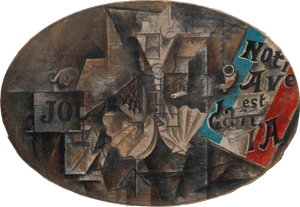12.22.23 — Cubism in Brooklyn
Pablo Picasso did not come easily to New York. He had a solo show in 1911 at its most innovative gallery, but it sold all of two drawings—one of them to the dealer himself.
Alfred Stieglitz, the photographer, had opened his gallery in Greenwich Village six years earlier, but for Americans, it seems, that was just not long enough to grow accustomed to modern art. Two years later,  Cubism made a sensation, but not with Pablo Picasso. Its appearance in the legendary Armory Show provoked outrage and enthusiasm, in the form of Nude Descending a Staircase, by Marcel Duchamp. Before both shows, though, Picasso found a buyer not on Fifth Avenue, but in Brooklyn. Now the Met tries to recreate the 1910 commission, through January 14.
Cubism made a sensation, but not with Pablo Picasso. Its appearance in the legendary Armory Show provoked outrage and enthusiasm, in the form of Nude Descending a Staircase, by Marcel Duchamp. Before both shows, though, Picasso found a buyer not on Fifth Avenue, but in Brooklyn. Now the Met tries to recreate the 1910 commission, through January 14.
Modernism’s shocks are easy to remember, but harder over time to explain. Picasso has become a fixture, loved and hated, and an earlier show looked at nothing but his impact on American art. For years before its repatriation to Spain, Guernica seemed inseparable from New York and the Museum of Modern Art. As for Nude Descending a Staircase, it was not even a nude. Maybe that is what shocked most. Yet it had nothing on the radicalism of the work destined for Brooklyn.
Hamilton Easter Field asked for eleven paintings, for the library of his townhouse in Columbia Heights. They never made it across the Atlantic. Field, who had met him not long before, died before the job was done. The Met claims to have identified six completed paintings, on view with eight drawings, but who is to say? It does not have much to go by, beyond the dimensions of the library. Field gave detailed specs for the room as a whole and where paintings would fit, at least two of them over doors. This was site-specific work, but not a mural or, for that matter, a single work.
Picasso had mixed feelings work on commission, if not America itself. In a letter to Gertrude Stein, he dismissed the whole project as mere decoration and something he just had to do. Yet he dug right into it. He began with sketches on vacation in Cadaquês, the coastal village just outside Barcelona. He was happy enough with the surviving paintings to have signed them, and why not? This was the very height of Analytic Cubism, and Field had given him the chance to push his limits.
Would the American (himself an artist, dealer, and critic) have known what he was getting? He was that second buyer for Stieglitz, and he bought an accomplished nude (on display here) from around 1905, in Picasso’s eminently accessible Pink Period. By 1910, Cubism was dismantling not just the human figure, but painting itself. Pen and oil hatching plays against the white of canvas and paper. It allows brown and blue to play against one another as well. Picasso would never work so densely or so close to abstraction again.
Two of the six paintings are nudes, standing or reclining in accord with the library’s available space. Two are still life, and two are women playing the mandolin or guitar (possibly Marie Laurencin, whose paintings stood out this fall at the New York art fairs, in the Independent)—but just try to envision their subject. Just last year the Met claimed Synthetic Cubism for trompe l’oeil painting, but this is a radical assault on illusion. Nor is it, in a clichéd view of Cubism, a compendium of optical points of view. It is a compendium of ways to look and ways to think about painting. That is why Modernism is still a challenge for Postmodernism and art today.
Read more, now in a feature-length article on this site.